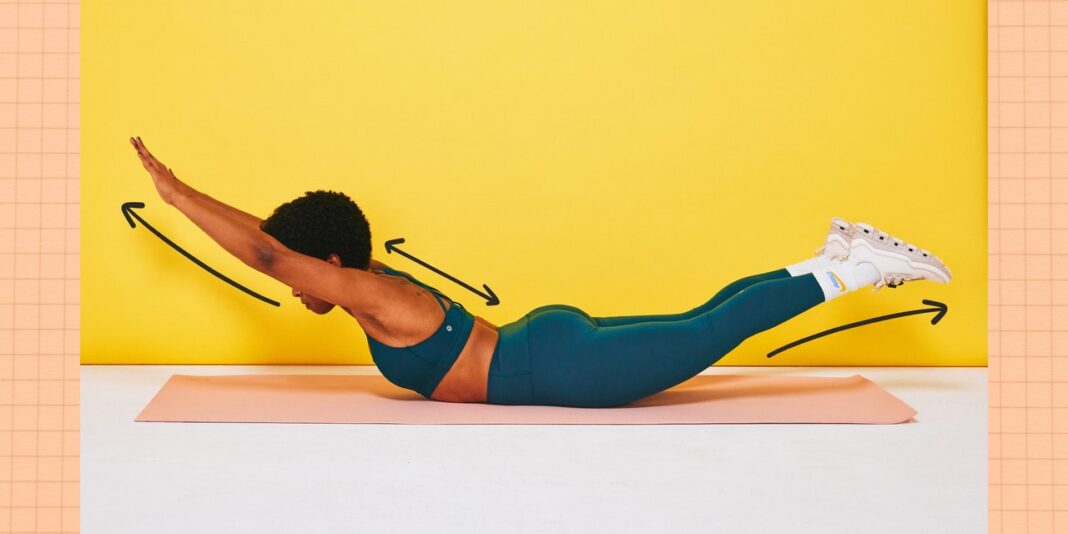Keep in Mind: The Superman Exercise is Not About Raising Your Arms and Legs Higher
Keep in mind if you raise your arms and legs higher, you’re not necessarily engaging more muscles or doing an advanced version of the move—it just means you have greater range of motion in back extension, Dr. Haas explains. In fact, for some people, keeping their limbs closer to the ground will deliver more of a challenge.
What are the Benefits of the Superman?
The Superman probably isn’t what you envision when you picture core exercises—chances are, moves like crunches, sit-ups, or planks more readily come to mind—but it technically a core move. That’s because your core isn’t about your abs (those frontside torso muscles): It also includes the ones in your lower back, too. And for your core strength to be as well-rounded as possible, it’s important that these muscles get worked, which is where the Superman can come in clutch, especially if you typically just do crunch-type ab moves. In particular, building lower back strength can help you stabilize better as you perform bigger moves, like squats, allowing you to do them more effectively and safely.
Beyond that, the Superman exercise can help folks who have lower back pain caused by lots of time spent sitting and leaning forward, like those of us who work desk jobs and thus spend the day in a flexion-based pattern, where we’re rounding our spine. Since the Superman moves the body in the opposite direction, into an extension-based pattern where your spine arches back, it can help undo the tension created from parking our butts in a chair all day. Not only does the Superman open up the back in the opposite direction, but it can help alleviate tightness in the front of the hips, too.
What Kind of Exercise is the Superman?
The move certainly makes your muscles quake, but it also puts your back into a bendy position, which begs the question: Is the Superman a strength move or a mobility drill? The verdict: “It’s officially a strength exercise,” Dr. Haas says. In fact, she warns t using it for mobility gains, since it’s really not intended for that—similar to how you shouldn’t grab a pair of dumbbells and do deadlifts if your goal is to lengthen your hamstrings. In the Superman, “you’re not trying to out the front side by going into an arch,” Dr. Haas explains. “You’re trying to the posterior chain.”
What are Common Superman Form Mistakes?
The goal of the Superman is to fire up your posterior chain, so that’s where you should feel muscles working, Dr. Haas explains. But it shouldn’t be painful, so if you feel pinching in your lower back or neck, or crankiness in your shoulders, as you do this exercise, it could mean you’re dealing with some muscle tightnesses that warrant making some adjustments so you can do it more comfortably.
Conclusion
The Superman exercise is a valuable addition to any workout routine, as it targets the muscles in your lower back and can help alleviate lower back pain. By understanding the benefits and proper form, you can get the most out of this exercise and experience improved core strength and overall stability.
FAQs
Q: Is the Superman exercise only for advanced fitness enthusiasts?
A: No, the Superman exercise is suitable for anyone looking to improve their core strength and alleviate lower back pain.
Q: Should I raise my arms and legs higher to engage more muscles?
A: No, raising your arms and legs higher only increases your range of motion in back extension and doesn’t necessarily engage more muscles. In fact, keeping your limbs closer to the ground may deliver more of a challenge for some individuals.
Q: Can the Superman exercise help with lower back pain caused by sitting at a desk?
A: Yes, the Superman exercise can help alleviate lower back pain caused by sitting at a desk by moving the body in an extension-based pattern, which can help undo the tension created from sitting in a flexion-based pattern.





